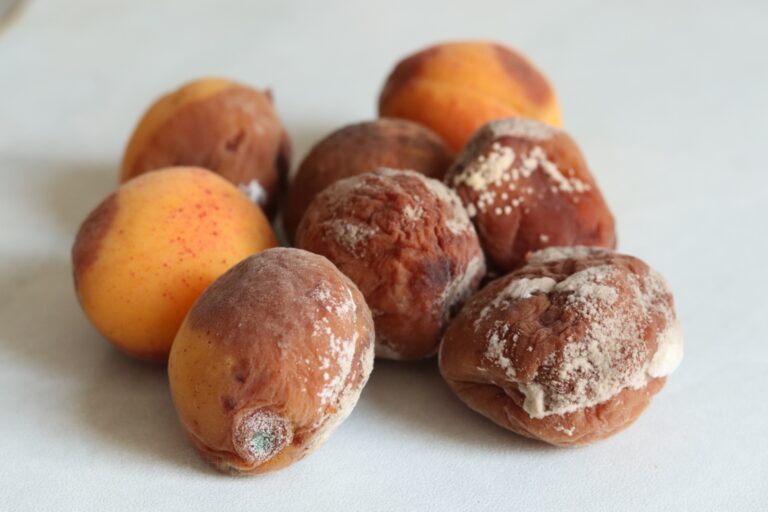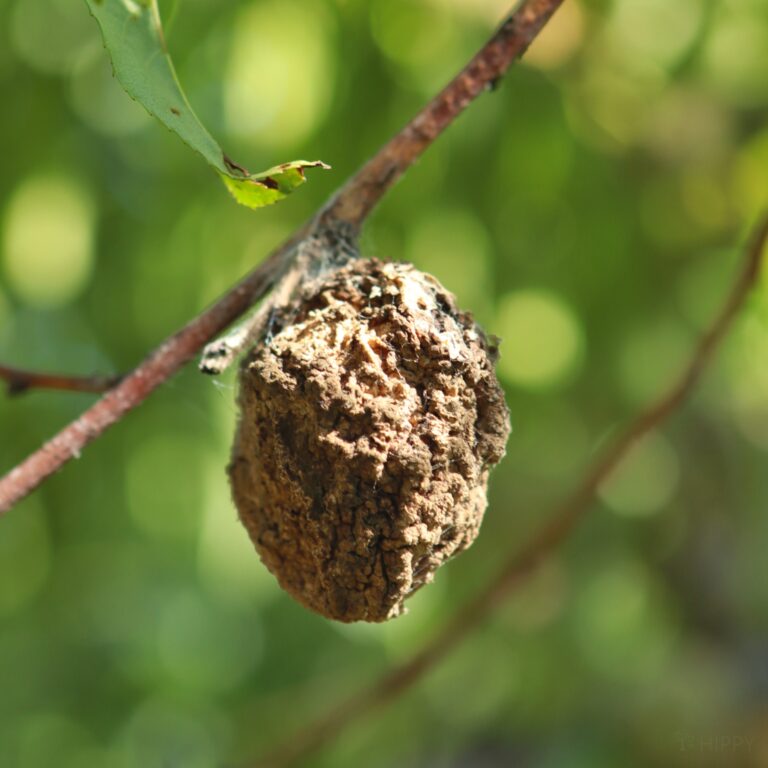It seems that wet weather in the spring is just about standard where I live. It never fails – the weather will be warm and wet, and then, out of nowhere, super cold. Occasionally we even get a late springtime snow!
For most people, this can spell disaster in the garden. There are all kinds of fungal diseases that thrive in warm, moist conditions – with one of the most pernicious for fruit trees being brown rot fungi.

If you’re looking for tips on how to eradicate brown rot fungi in your garden, rest assured – it can be done. Here’s what you need to know.
What is Brown Rot Fungi?
Brown rot is a fungal disease that most often affects fruit trees – particularly stone fruit trees like cherries and peaches.
It can be difficult to control, particularly if you have experienced a constantly humid, wet, or warm spring.
This disease affects most parts of the tree, including the flowers and fruit. A strong, healthy tree can survive, but a young or weakened tree can easily be killed. Therefore, it’s essential to know what exactly this disease is – as well as how to prevent and control it – to keep your crop safe.
Brown rot is a fungal disease caused by a specific species of fungi known as Monilinia fructicola.
What Kinds of Plants Are Affected by Brown Rot Fungi?
Just about any kind of stone fruit tree and their fruits can be affected by brown rot fungi. Some of the most commonly affected plants are apricots and apriums, peaches, plums, pluots and plumcots, nectarines, and both sweet and sour cherries.
There are some cultivars of these individual plant species that are resistant to brown rot fungi, however. These include Harglow Apricots, Hardired Nectarines, and Venture Peaches.
What Are the Symptoms of Brown Rot Fungi?
Brown rot fungi presents several easily identifiable symptoms.
The first indicates the site of infection, and its blossoms that are brown and wilted. You might also notice sunken dark spots on new, developing shoots or leaves that are brown and hanging lifeless from infected limbs.
After fruit develops, you may notice that affected pieces start to grow tiny spots of rot. These get larger quite quickly, and rotted fruit rapidly develops grey or tan spores that are fuzzy and appear to cover the entire part of the plant.
If you leave the fruit on the plant, it will darken, shrivel up, and harden with a “mummified”-looking appearance.
These pieces need to be removed immediately upon discovery because, left on the ground, they will encourage the fungal cycle to continue. Your trees will continue to be infected by the fungi.
Brown rot overwinters in mummified fruits both on the ground and on the tree, as well as infected twigs. It has a viciously tenacious life cycle that enables it to keep coming back, year after year.
You’ll first notice signs of the disease first thing in the spring, when blossoms are infected. Later, the disease will grow back into the smaller branches, creating cankers that kill stems.
You might also notice large numbers of stems bearing flowers are killed once the disease becomes more severe.
What’s interesting about this fungal disease, as compared to some of the other more common fungal diseases, is that mature or developing fruits will have brown, circular spots that mature quickly – but any tissue that has rotted will remain dry and firm.
Brown spot fungi can be difficult to get rid of, as the spores can be carried by the wind, insects, and rain to unopened and opened blossoms and to young shoots.
Basically, as long as water is present, the spores can germinate. It spreads quickly and can rapidly destroy the entire crop of a tree.
How to Prevent Brown Rot Fungi
Keep the Growing Area Clean and Well-Maintained
The best tip at preventing brown rot fungi is to maintain a growing area that is clean, clear, and well-maintained. This can prevent a large list of other diseases and pest problems, too.
Ideally, you should plant in a location that is well-drained and provide your plants with full sunlight (about six to eight hours during the primary growing season).
Prune your trees regularly to open them up to good light and air circulation, which can help fight fungi, and get rid of any other trimmings left over after you have pruned.
Leaving this debris on the ground can create sites that will harbor fungi.
You should also remove any damaged or diseased limbs and fruit. These are more likely to be susceptible to infection. When your fruits are growing, thin those that grow close together, as they’re more likely to spread infection.
Keep Insect Pests at Bay
While brown rot fungi can affect any plant, weak or strong, plants that have been weakened by diseases or insects tend to be the most susceptible to infestation. Insects like vinegar flies, honey bees, and sap beetles can transport spores.
Worse, they tend to be attracted to rotted brown fruits and can leave spores on fruits that are otherwise healthy, making it more likely that the disease will spread to other fruits on the plant.
Therefore, do what you can to reduce insects in your garden. You may need to apply organic pesticides or home remedies to keep certain problematic insects off your plants.
Keep in mind that some insects really can’t (and shouldn’t) be prevented. For example, honeybees need to be around to pollinate your trees, and you shouldn’t take steps to eliminate them.
Choose Resistant Varieties
Whenever possible, choose varieties of fruit trees that are resistant to brown rot fungi. They won’t necessarily be 100% immune, but they might be more resistant than other kinds of plants.
Use a Pruning Sealer
Pruning your trees frequently is essential to help improve air circulation. Similarly, watering from below can help prevent water from getting on foliage, fruit, and blossoms.
However, it’s not just enough to prune – you should also make sure you are taking care of your plants after they have been pruned, too.
Use a pruning sealer to seal up any wounds or cuts, whether intentional or not. As an added bonus, this will protect against other diseases and insects, too.
Guard Against Temperature Fluctuations
You can’t control the weather – but unfortunately, brown rot fungi is more common in humid, wet conditions. In fact, under warm conditions, mature fruits can decay in just two days.
There is one step you can take to prevent the spread of fungi. Brush the bark of your trees with white latex paint (ideally, diluted with a bit of water). It may look odd, but this will actually help seal the bark and protect it against harsh temperature fluctuations.
Harvest Fruits Carefully
When it comes time to harvest, be mindful of how you are harvesting your fruit. Handle it carefully both during and after harvest to prevent bruising and make sure you store it in a cold environment.
If any fungal spores happen to be on the fruits (that haven’t quite settled in yet) you may be able to prevent problems by keeping the fruit cold.

How to Eradicate Brown Rot Fungi
Proper Sanitation
Just as good sanitation is a key step in preventing brown rot fungi, it’s also important when it comes to eradicating it.
As soon as you notice any signs of infestation, prune away any diseased areas on the limbs. Clean your pruners between cuts and dispose of your pruning debris. This will help you prevent contaminating the rest of your plants.
Avoid the urge to compost any parts that you cut off – the fungus can live for quite a long time, even in a hot compost.
Try Orchard Spray
Some people use orchard spray on their fruit trees. This spray is somewhat of a one-size-fits-all solution for all kinds of fungal and insect problems.
Usually containing pyrethrins and sulfur, this spray can be used as a preventative early in the season or later on, particularly when newer shoots of the plant are affected.
Use a Fungicide Spray
There are several kinds of fungicide sprays you can use to combat brown rot in the garden. These include wettable power fungicides, liquid concentrate fungicides, and natural copper-based fungicides sprays and dusts.
You should use these sprays preventatively if you know that brown rot is a problem in your area – even if you haven’t noticed any symptoms yet.
Just make sure you choose a spray that’s recommended for use on the specific kind of tree you are spraying. Most can be applied first thing in the spring, and then again later on as needed.
If you decide to use a fungicide on your plants, consider rotating and alternating between them for various seasons. The fungus can become resistant to certain fungicides when they are applied repeatedly.
Prune Heavily
The good news is that brown rot fungi doesn’t have to be the end of your trees. The bad news is that, once your fruits are infected, there’s no turning back – they are goners.
You will need to prune infected twigs about four to six inches below the head tissue, and dispose of them by burying or burning them.
Use rubbing alcohol or a spray disinfectant to your pruning tools between cuts.
Eradicate Brown Rot Fungi With Patience and Vigilance
Ultimately, brown rot fungi is not the most common garden disease – but it can be one of the most frustrating. To get rid of it, you’ll need to monitor your trees carefully and take action quickly if any of your trees begin to show signs of disease.
With a bit of intervention, you can prevent this fungus from spreading throughout the rest of your orchard – and from coming back next year.

Rebekah is a full-time homesteader. On her 22 acres, she raises chickens, sheep, and bees, not to mention she grows a wide variety of veggies. She has a huge greenhouse and does lots of DIY projects with her husband in her ever-growing homesteading endeavor. Learn more about Rebekah here.

Do you have a recommendation for spray that is safe for bees? I have a peach tree that I has been infected with peach tree borers and brown rot. I got rid of the borers with nematodes and was able to spray the peach tree once this year (before I got bees), but my spray states it is not safe for bees.